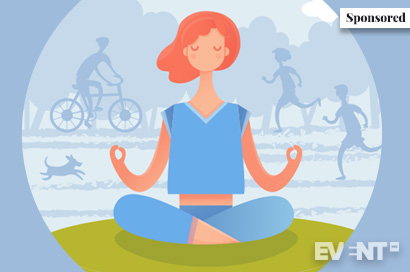This is a sponsored post by Maritz Global Events. More information about Event Manager Blog’s sponsored posts.
The wellness trend began by offering healthier meal options but has now blossomed into an entire culture for events. As people’s personal values are developing and they become more mindful in their personal lives, their expectations for meetings and conferences are changing as well. Incorporating them into the event atmosphere is necessary to maintain a competitive edge over others trying to ride the wellness trend.
What makes addressing wellness different from other event trends? Wellness is values-based. It is an action, not just a culture. That means instead of simply adding a wellness feature or offering, it creates a shift in how event planners view their events.
It’s a value that’s not going away. Wellness is the underpinning standard with which every decision is held to:
Is this good for the audience?
How does this affect the wellness of the audience?
Create a Culture of Wellness to Align Your Event with Your Audience Preferences
In the past, many event planning decisions had been made to incorporate one or two elements of a design trend, thinking about the experience it creates. With wellness in events, it’s about embracing a shift to creating a value and culture that is in line with the audience’s personal lives. Wellness is an ideal that should permeate every area of the event.
Delight Attendees by Moving Past Salads with Specialized Menus
The first part of the wellness trend appeared in the event menu, moving from less processed foods to more green offerings. But it hasn’t stopped there. Serving plenty of health-conscious options is a good start but these days healthy, clean eating and special diets mean much more than low-cal options. There are dietary considerations, local farm to table movements, and a host of other desired meal preferences outside of the standard side salad.
But wellness-focused menus aren’t just for mealtime. Healthy snacks are important too. Protein packed, low-sugar options, and fruit are big winners in wellness. Some events are adding customization to their wellness offerings through the introduction of smoothie and juice bars. Hydration stations are cropping up everywhere.
And these menu changes aren’t just designed to fit guests’ changing diets. They help improve concentration and attention. Too many carbs and sugars can lead attendees to lose focus in the afternoons making sessions during those times less productive and effective. Keep the menus clean and filled with “good” carbs to avoid the afternoon slump and keep engagement high.
Cover Topics of Interest with Real-life Application
The global wellness industry is booming. According to the Global Wellness Institute, it reached a whopping $4.2 trillion spend in 2017 and is expected to grow in the next year. As more people embrace things like wellness tourism, anti-aging, and personalized alternative medicine in their personal lives, topics like work-life balance, meditation, better sleep programs, mental health awareness, nutrition tips, and stress management sessions will become very popular offerings at most events.
Pampering is also another option that’s growing in popularity. At the Swisse Wellness activation at Wanderlust 108, they created a walled-in area comprised of blood oranges and greenery that was the perfect backdrop for sampling their hair, skin, and nails formula made from blood oranges. The relaxing braid bar featured salon professionals who pampered attendees with hair-braiding services. Their Dream Dome provided a relaxing oasis in which attendees were educated about how to lower cortisol levels naturally.
These topics are more than just professional suggestions. They provide real-life application that can help attendees feel more productive and less stressed in all areas of their lives.
Suggest Offline Time to Increase Focus
This wellness tactic is one most people will agree with but find hard to implement in their lives. Reducing screen time has been linked to better quality sleep, lower BMI, reduced anxiety and stress, and improved focus. There are great benefits to these things for the conference but also the attendee.
Still, while many agree on the benefits, they find it difficult to do in reality. Event planners are in a unique position to “allow” guests to unplug. They can require it for certain mindfulness sessions or even a mindfulness morning, taking the burden of self-unplugging from the guest. They will feel like they unplugged because they were instructed to. Some people find this much more palatable than self-directed unplugging. As an added bonus, it will result in stronger connections with the event and one another.
Offer Interactive Sessions and Activities That Solve Problems
Sometimes the event planner recognizes a need within the attendees’ lives before they do. The Financial Services Institute created a meeting for financial advisors by financial advisors. They quickly learned that their ideal demographic was struggling with work/life balance and so they instituted a wellness component into their meetings. They started the day with varied workouts and built in an extra hour after the workouts ended for participants to get ready for the upcoming conference sessions.
Some event planners are intertwining their programming with wellness programming. The Warrior Wealth Leadership and Business Summit in California incorporated a high-intensity workout circuit of burpees, squats, and other grueling cardio. The program was tacked onto the beginning of the day as a way to incorporate wellness ideas. It set the tone for the entire conference.
Other event planners introduced yoga, meditation, jogging/running groups, or specialized physical challenges. Another option for adding wellness activities to any event is producing a one-sheeter or info in an app on local trails, running courses, biking paths, yoga studios, and meditation classes that are nearby.
Schedule Breaks for Effective Program Planning
Scheduling in breaks for networking and connections with other attendees, or to check in with the office and keep stress levels in check is necessary because people are individuals with personal needs as well as social creatures with collective needs and desires to be together.
Changing the culture, moving past experiences, and embracing a culture of wellness brings value to lives. This is more than a session or two. It needs to permeate the entire atmosphere of the event with decisions made about the event weighed against the idea of promoting wellness among participants and the event team. This includes areas of event design, flow, schedule, use of elements and senses, ergonomic arrangements/furniture, etc.
While the event planner is not the event parent and they can’t force guests to get plenty of rest at a multi-day event, they can keep scheduled events in the evening down to a minimum and have at least one day where sessions begin later. This facilitates attendees getting more rest. Having breaks in the day can help them attend to responsibilities with their work that might otherwise pile up at the end of the day or have to get worked in at the beginning before sessions start; either way, interfering with healthy sleep.
Offer Sponsors a New Way to Engage With Your Audience or Attract a New Type of Sponsor
Another critical piece to a wellness culture is to ensure the sponsors chosen represent the move to a wellness-centric event. The first step to communicate the change to sponsors is to make sure they are onboard with the new direction. Do this by marketing the wellness track and offerings for increased visibility. Companies interested in that event angle will naturally be attracted to the shared vision. Next, actively approach non-sponsor companies that are a good fit for sponsorship and vendor relationships. Select partners that share the wellness vision. Finally, offer creative sponsorships that give these organizations an opportunity to provide wellness activities and offerings to the audience. This should be appealing to the right kind of partner. Not only might it advance their mission and place them in front of the event audience, but it does so through providing a positive experience. Attendees will have a positive emotional response to the sponsor’s offerings and thus apply those feelings to the business as well.
At the Be Well Lounge at IMEX America, participants enjoy physical challenges including a walking group and a quiet lounge in which to regroup. But what sets these activities apart is that most of them were sponsored so the event planners could offer these things within their existing budgets.
Select Venues That Support Wellness to Emphasize the Mission
If wellness is a goal for the conference, it must be incorporated into every aspect of the event. One of those areas is selecting a venue that supports the wellness mission. Some venues require the use of approved caterers and if those caterers do not have wellness options, the event premise will fall flat upon delivery.
Instead, look for venues that support wellness pursuits and can accommodate food and activities. For instance SAVOR, the caterer at McCormick Place in Chicago, sources some of its food from its 2.5-acre rooftop gardens. It is also committed to using non-antibiotic-raised meats. For event planners who embrace the wellness lifestyle, finding a venue and vendors that support it is essential to the plan’s success.
Add an Element of Giving Back to Enhance the Overall Wellness Experience and Give Back to the Host City.
By making a difference and doing some good in the local community, attendees will walk away from the meeting satisfied that they contributed and stepped outside of themselves. Studies show that when people give back they are likely to become a loyal customer.
In the consumer world, 84% of customers agree that brands have a responsibility to make the world a better place. And that feeling is starting to be a major factor why organizations incorporate a corporate social responsibility (CSR) experience into their meeting. They want that brand loyalty and recognition.
A new event has been created to offer a deeper dive into wellness and meetings. The Health and Wellness Forum coming up in February of 2019 in Chicago will fully immerse the attendee into a healthy experience while educating planners on how to design events to successfully integrate wellness into a meeting that not only appeals to long-time attendees, but attracts new attendees as well. This grassroots event was created by three industry professionals who believe meeting design must change to be healthy and that meeting professionals also need to take their own wellness into consideration to be at the peak of their performance.
IN CONCLUSION
Incorporating wellness in today’s events is much more than just adding a few healthy eating choices to the menu. There is an entire culture built around the wellness movement and to embrace it authentically means offering more than trendy dishes. It revolves around improving the lives of attendees through value-based design. For event and conference planners who are able to do that, their event becomes a must-attend year after year.






